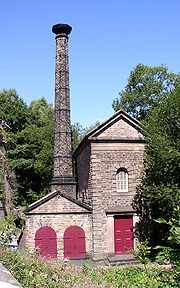
Leawood Pump House
Encyclopedia
The Leawood Pump House was built in 1849 to supply water to the Cromford Canal
, built some 50 years previously. It is a Grade II* listed building.
 Located a little along the canal towpath from High Peak Junction
Located a little along the canal towpath from High Peak Junction
, it stands to a height of 45ft on the right bank of the River Derwent
, at the end of the Derwent Aqueduct, and has a 95ft chimney stack with a cast-iron cap.
The Watt-type beam engine was designed and erected by Graham and Company of Milton Works, Elsecar
, Sheffield. The beam length is 33ft, the piston diameter 50 in, stroke of 10ft and the engine works at 7 strokes per minute. The boilers, replaced in 1900 have a pressure of 40 p.s.i.
Water is drawn from the River Derwent
through a 150 yard tunnel to a reservoir in the basement. It is then lifted 30 ft and discharged into the canal.
The immense size of the pump (which can transfer almost four tons of water per stroke and seven strokes a minute, a total of over 39,000 tons of water per 24 hours) is explained by the fact that there were restrictions on removing water from the Derwent river, this being allowed only between 8 p.m. on Saturdays and 8 p.m. on Sundays.
The pumphouse worked continuously from 1849 until 1944 when the canal closed. It was restored in 1979 by the Cromford Canal Society and is run periodically.
Cromford Canal
The Cromford Canal ran 14.5 miles from Cromford to the Erewash Canal in Derbyshire, England with a branch to Pinxton. Built by William Jessop with the assistance of Benjamin Outram, its alignment included four tunnels and 14 locks....
, built some 50 years previously. It is a Grade II* listed building.

High Peak Junction
High Peak Junction, near Cromford, Derbyshire, England, is the name now used to describe the site where the former Cromford and High Peak Railway , whose workshops were located here, meets the Cromford Canal...
, it stands to a height of 45ft on the right bank of the River Derwent
River Derwent
River Derwent is the name of several rivers in England:*River Derwent, Derbyshire*River Derwent, North East England on the border between County Durham and Northumberland*River Derwent, Cumbria in the Lake District*River Derwent, Yorkshire in Yorkshire...
, at the end of the Derwent Aqueduct, and has a 95ft chimney stack with a cast-iron cap.
The Watt-type beam engine was designed and erected by Graham and Company of Milton Works, Elsecar
Elsecar
Elsecar is a village forming part of the Metropolitan Borough of Barnsley in South Yorkshire, England. Like many villages in the area, it was for many years a coal mining village until the widespread pit closures during the 1980s. Elsecar is next to the villages of Hoyland and Jump.Elsecar is...
, Sheffield. The beam length is 33ft, the piston diameter 50 in, stroke of 10ft and the engine works at 7 strokes per minute. The boilers, replaced in 1900 have a pressure of 40 p.s.i.
Water is drawn from the River Derwent
River Derwent, Derbyshire
The Derwent is a river in the county of Derbyshire, England. It is 66 miles long and is a tributary of the River Trent which it joins south of Derby. For half its course, the river flows through the Peak District....
through a 150 yard tunnel to a reservoir in the basement. It is then lifted 30 ft and discharged into the canal.
The immense size of the pump (which can transfer almost four tons of water per stroke and seven strokes a minute, a total of over 39,000 tons of water per 24 hours) is explained by the fact that there were restrictions on removing water from the Derwent river, this being allowed only between 8 p.m. on Saturdays and 8 p.m. on Sundays.
The pumphouse worked continuously from 1849 until 1944 when the canal closed. It was restored in 1979 by the Cromford Canal Society and is run periodically.

